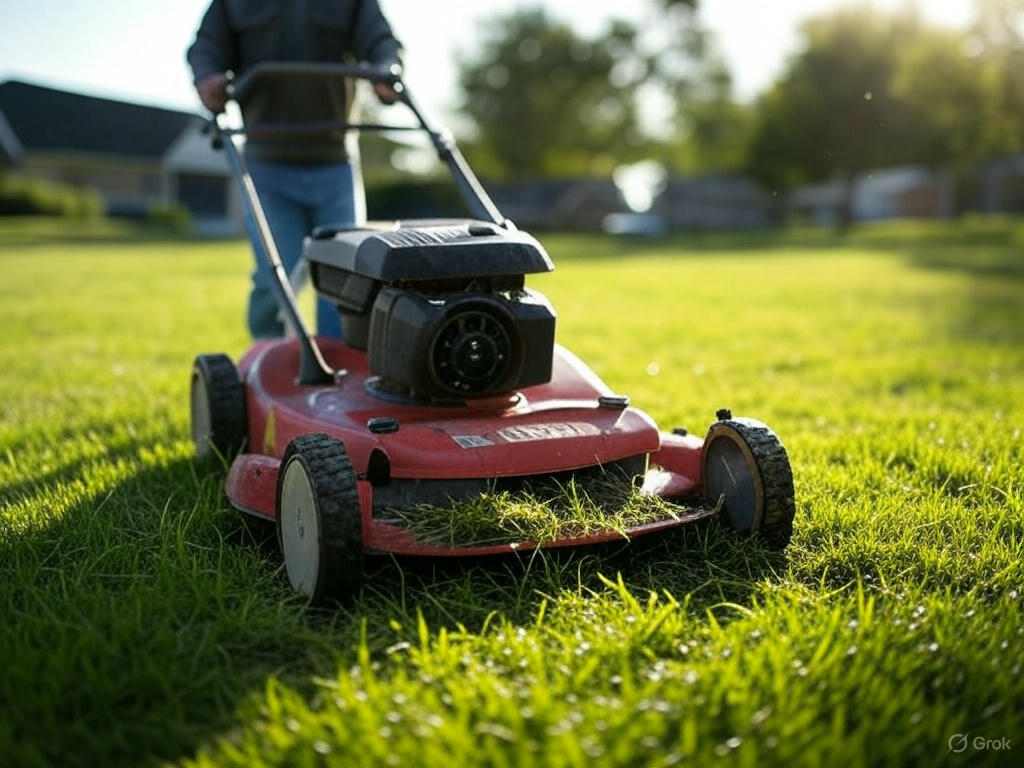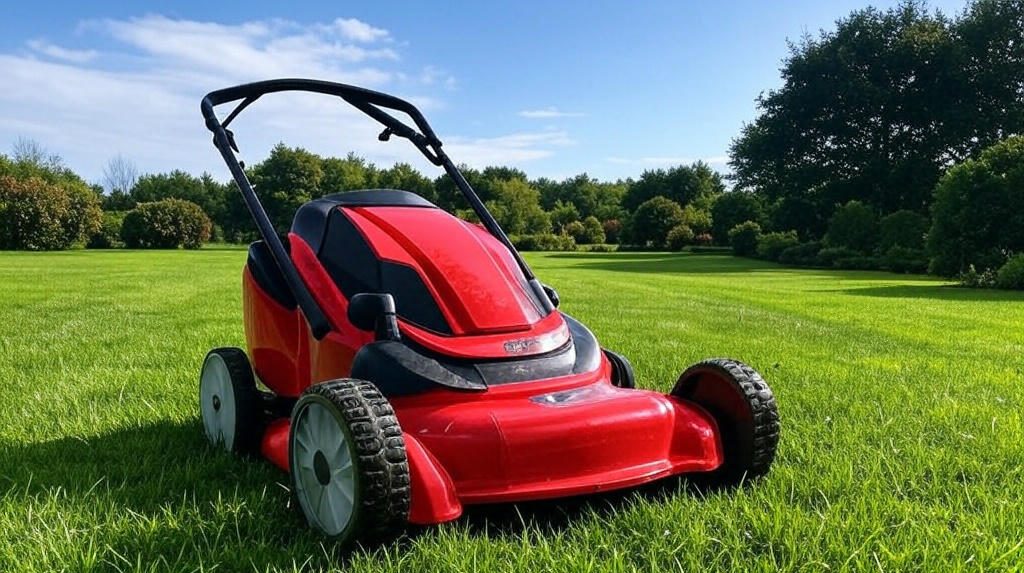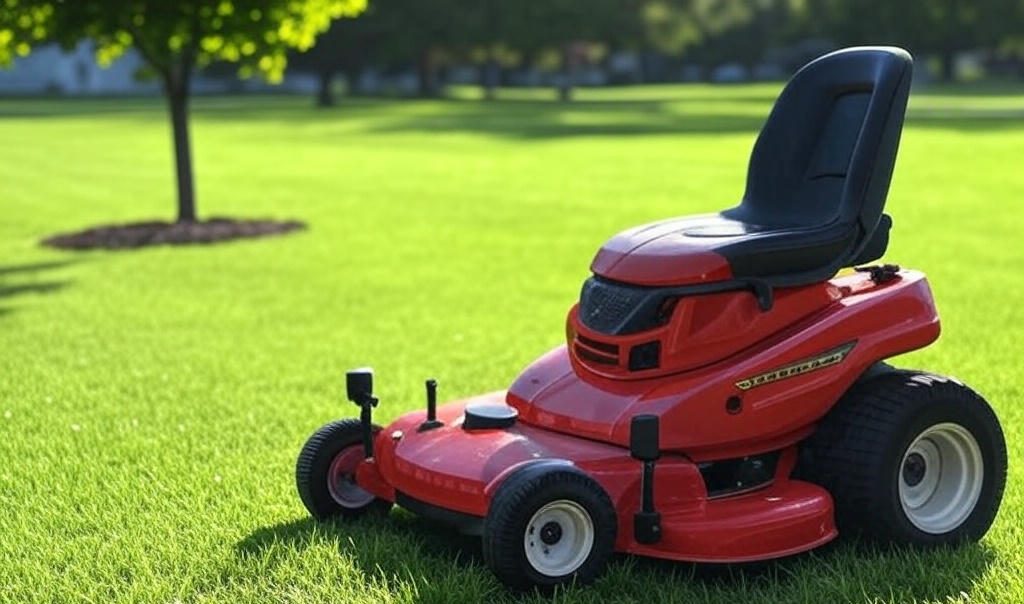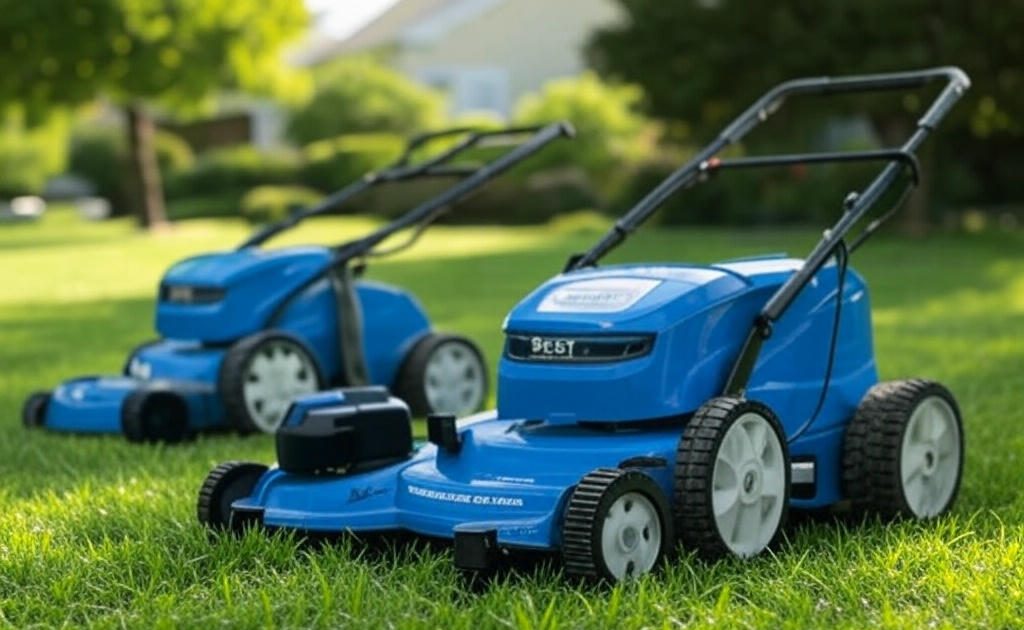Contents
- Introduction
- Why Choose a Robot Lawn Mower?
- Key Factors to Consider When Buying a Robot Lawn Mower
- Top 5 Robot Lawn Mowers for 2025
- Comparison Table: Key Features at a Glance
- Understanding Navigation Systems: Boundary Wire vs. RTK
- Lawn Size and Battery Life: Finding the Right Balance
- Slope Handling: Important for Hilly Properties
- App Functionality and Smart Home Integration
- Maintenance Requirements
- Budget Considerations and Long-Term Value
- Who Should Consider a Robot Lawn Mower?
- Final Thoughts: Choosing Your Perfect Robot Mower
- Frequently Asked Questions
Introduction
Gone are the days of spending your weekends pushing a heavy lawn mower under the scorching sun. Robot lawn mowers have revolutionized lawn maintenance, offering a hands-free solution that keeps your yard looking pristine with minimal effort. These smart devices work like indoor robot vacuums but are designed specifically for your outdoor space, cutting grass autonomously while you relax or focus on other tasks.
The market for robotic lawn mowers has grown substantially in recent years, with impressive technological advancements making these devices more efficient, smarter, and more capable than ever before. From wire-free navigation systems to AI-powered obstacle detection, today’s models offer features that were once considered futuristic.
In this comprehensive guide, we’ll dive deep into the top robot lawn mowers available in 2025, comparing their features, performance, and value to help you choose the perfect automated gardening assistant for your needs.
Why Choose a Robot Lawn Mower?
Before we explore the specific models, let’s understand why robot lawn mowers have become so popular:
Time-saving: Once set up, these machines work independently, freeing up your weekends for activities you actually enjoy.
Consistent results: Robot mowers cut little and often, maintaining an ideal grass height that promotes lawn health.
Environmentally friendly: Most models are battery-powered, eliminating emissions and reducing noise pollution compared to gas mowers.
Mulching benefits: The tiny grass clippings act as natural fertilizer, returning nutrients to your lawn.
Reduced physical strain: No more pushing heavy equipment or dealing with hot, uncomfortable lawn maintenance sessions.
Smart technology: Many models connect to apps, allowing precise scheduling and monitoring from anywhere.
Key Factors to Consider When Buying a Robot Lawn Mower
When shopping for a robotic lawn mower, several factors will determine which model best suits your needs:
Lawn size capability: Ensure the mower can handle your yard’s square footage.
Navigation system: Traditional boundary wires vs. newer wire-free RTK/GPS systems.
Slope handling: If your yard has inclines, look for models with strong climbing abilities.
Battery life: Longer runtime means more efficient mowing, especially for larger properties.
Cutting height range: Different grass types require different cutting heights for optimal health.
Weather resistance: Quality models should handle light rain and various weather conditions.
Obstacle handling: Advanced sensors help avoid collisions with trees, furniture, and other yard objects.
Security features: Anti-theft protection keeps your investment safe.
App capabilities: User-friendly interfaces make scheduling and customization easy.
Now, let’s look at our top picks for the best robot lawn mowers in 2025:
Top 5 Robot Lawn Mowers for 2025
1. ECOVACS Goat O1000 RTK Robot Lawn Mower
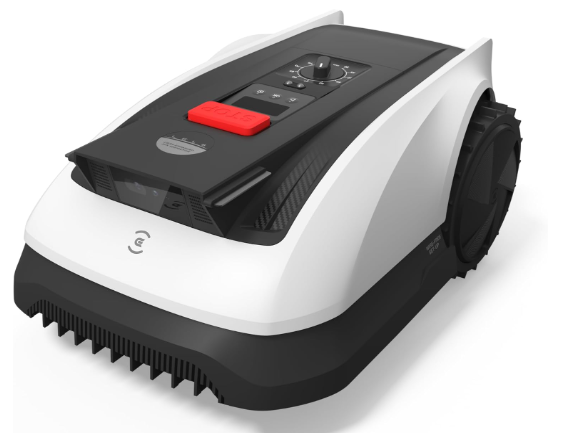
Key Specifications:
- Yard Size Capability: 1/4 acre
- Navigation System: Perimeter wire-free RTK & Vision
- Special Features: Automated mapping, app control, 3D obstacle avoidance, zero-edge cutting
- Battery Life: Approximately 140 minutes per charge
- Cutting Height: 1.5″-3.0″
- Weight: 24.7 lbs
- Noise Level: 59 dB
What We Like
The ECOVACS Goat O1000 stands out as a technological marvel in the robot lawn mower space. Its wire-free setup eliminates the tedious process of installing boundary wires around your yard, making installation quick and straightforward. The combination of RTK (Real-Time Kinematic) satellite navigation and visual recognition creates precise mapping capabilities that traditional systems simply can’t match.
The 3D obstacle avoidance system deserves special mention. Unlike basic sensors that merely detect objects, the Goat O1000 uses advanced cameras and AI to identify and categorize obstacles in real-time. This means it can distinguish between permanent features like trees and temporary obstacles like toys, adjusting its cutting pattern accordingly.
The zero-edge cutting feature tackles one of the most common complaints about robot mowers—their inability to reach edges. The Goat O1000’s design allows it to cut remarkably close to boundaries, reducing the need for manual trimming after the robot completes its work.
The ECOVACS app provides intuitive control over scheduling, cutting heights, and zone management. The mapping function lets you visualize exactly where the mower has been and what areas still need attention.
Room for Improvement
While the Goat O1000 excels in many areas, its 1/4 acre capacity limits its suitability for larger properties. Users with extensive lawns will need to consider higher-capacity alternatives or purchase multiple units.
The cutting height range, while adequate for most common grass types, might not satisfy homeowners with specialized turf needs. Some users report occasional GPS signal issues in heavily tree-covered areas, though the visual navigation system usually compensates effectively.
The premium technology also comes with a premium price tag. This mower represents a significant investment compared to traditional lawn care equipment, though the time savings and convenience provide substantial value over time.
Best For
The ECOVACS Goat O1000 is ideal for tech-savvy homeowners with small to medium-sized lawns who want advanced features and minimal setup hassle. It excels in yards with complex layouts, multiple obstacles, or decorative edges that typically challenge lesser robot mowers.
2. LUBA Mini AWD 1500H Robot Lawn Mower with 4G

Key Specifications:
- Yard Size Capability: 0.37 acre (max 0.45 acre)
- Navigation System: UltraSense AI Vision + RTK Auto-Mapping
- Special Features: All-wheel-drive for 80% slope handling, 4G connectivity
- Battery Life: Up to 200 minutes
- Cutting Height: 2.2″-4.0″
- Weight: 28.6 lbs
- Noise Level: 62 dB
What We Like
The LUBA Mini AWD 1500H tackles challenging terrain like no other robot mower on our list. Its all-wheel-drive system conquers impressive 80% slopes (about 38 degrees), making it perfect for hilly properties that would stump competing models. If your yard features significant elevation changes, this capability alone might justify choosing the LUBA.
The inclusion of 4G connectivity proves incredibly useful, allowing you to monitor and control your mower from virtually anywhere. This feature eliminates the range limitations of Bluetooth or Wi-Fi only models, letting you manage your lawn maintenance even when you’re away from home.
The UltraSense AI Vision system works alongside RTK navigation to create detailed property maps without boundary wires. The system learns your lawn’s layout over time, becoming increasingly efficient with each mowing session. We found the mapping quality impressive, with the mower accurately identifying different zones and creating efficient cutting paths.
The 2.2″-4.0″ cutting height range provides flexibility for various grass types and seasonal conditions. This wider range allows for proper care of both delicate grasses that benefit from higher cuts and sturdier varieties that can be trimmed shorter.
Room for Improvement
Despite its impressive slope-handling capabilities, the LUBA Mini’s weight makes it somewhat challenging to manually transport between lawn sections if necessary. The higher noise level compared to some competitors might be a consideration for noise-sensitive neighborhoods.
Some users report a moderate learning curve with the app interface, which offers extensive customization but can feel overwhelming to less tech-oriented users. The initial setup and mapping process takes longer than some competing models, though the results justify the additional setup time.
The robust all-wheel-drive system that enables impressive climbing ability also consumes more battery power than two-wheel systems, potentially requiring more frequent charging for large properties.
Best For
The LUBA Mini AWD 1500H is the perfect choice for homeowners with sloped or hilly yards who need reliable performance on challenging terrain. It also suits users who travel frequently but want to maintain remote control over their lawn care through the 4G connectivity feature.
3. Worx Landroid L 20V 5.0Ah Robotic Lawn Mower
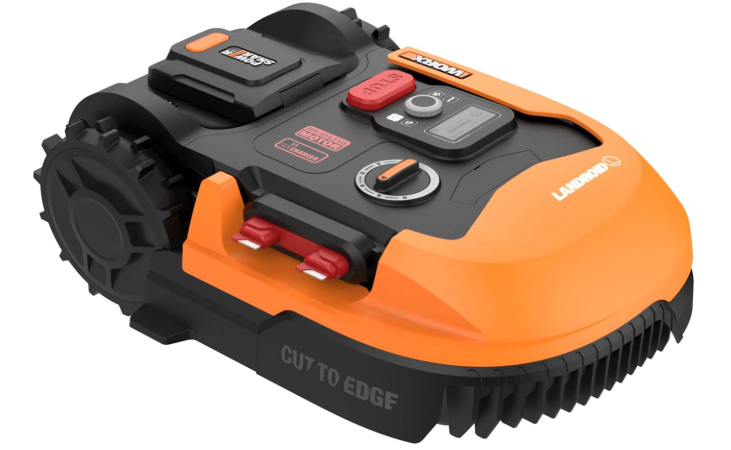
Key Specifications:
- Yard Size Capability: 1/2 acre (21,780 sq ft)
- Navigation System: Traditional boundary wire with AI navigation
- Special Features: Power Share battery compatibility, Cut to Edge design
- Battery Life: 90-120 minutes (interchangeable battery)
- Cutting Height: 1.5″-3.5″
- Weight: 21.2 lbs
- Noise Level: 63 dB
What We Like
The Worx Landroid L stands out as the value champion in our lineup, offering robust performance at a significantly lower price point than RTK-equipped competitors. While it uses traditional boundary wire rather than satellite navigation, this tried-and-true approach provides reliable operation with lower upfront costs.
The Power Share battery system deserves special recognition. The same 20V battery that powers the mower can be used in other Worx power tools, creating an ecosystem that provides excellent value for homeowners who already own Worx products. The ability to swap batteries extends functional runtime without waiting for recharging.
The Cut to Edge design minimizes the need for manual trimming, allowing the Landroid to mow closer to boundaries than many competitors. The AI navigation system efficiently plans cutting patterns, avoiding the random bouncing that characterized early robot mowers.
The Landroid’s app interface strikes an excellent balance between functionality and user-friendliness. Even those with limited technical experience can quickly master scheduling and customization features. The rain sensor automatically postpones mowing during wet conditions, protecting both your lawn and the mower.
Room for Improvement
The boundary wire installation represents the most significant drawback compared to wire-free models. Initial setup requires time and effort to lay and secure the wire around your yard’s perimeter and any obstacles. This process can take several hours depending on your lawn’s complexity.
The Landroid L handles moderate slopes up to 20 degrees, but this falls well short of the LUBA Mini’s impressive climbing ability. Homeowners with significant inclines should consider other options.
While the interchangeable battery system offers convenience, the 90-120 minute runtime per battery means larger yards may require battery swaps during operation for complete coverage. This reduces the “set and forget” benefit that makes robot mowers attractive.
Best For
The Worx Landroid L provides exceptional value for budget-conscious homeowners with relatively flat yards up to half an acre. It’s particularly attractive for those already invested in the Worx Power Share ecosystem or those who prioritize proven reliability over cutting-edge features.
4. Segway Navimow i110N Robot Lawn Mower
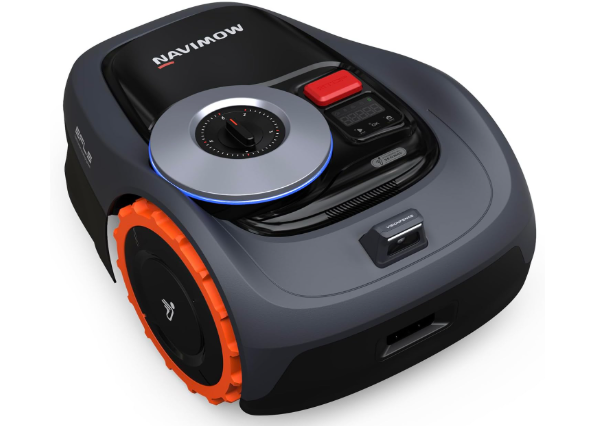
Key Specifications:
- Yard Size Capability: 1/4 acre
- Navigation System: Perimeter wire-free RTK + Vision
- Special Features: AI-assisted mapping, virtual boundary, multi-zone management
- Battery Life: Up to 150 minutes per charge
- Cutting Height: 1.2″-2.8″
- Weight: 22.9 lbs
- Noise Level: 58 dB(A)
What We Like
The Segway Navimow i110N brings the company’s transportation innovation expertise to lawn care, resulting in an exceptionally quiet and efficient mowing solution. At just 58 dB(A), it’s the quietest model in our lineup—imagine the volume of a normal conversation. This makes it ideal for noise-restricted neighborhoods or for those who enjoy outdoor relaxation without disruptive lawn equipment sounds.
The wire-free RTK navigation system paired with visual sensors creates precise mapping without physical boundary installation. The virtual boundary feature through the app allows you to easily adjust mowing zones without physical modifications to your setup.
Multi-zone management stands out as particularly useful for complex yard layouts. The Navimow efficiently handles separate lawn areas, scheduling appropriate cutting times for each zone based on size and growth patterns. The blade design creates an exceptionally clean cut that promotes lawn health and reduces disease risk.
The Segway app interface ranks among the most intuitive we’ve tested, with clear visualization of mowing progress and simple controls for adjusting settings. The sleek, modern design also makes the Navimow an attractive addition to your yard rather than an eyesore.
Room for Improvement
The cutting height range (1.2″-2.8″) offers less flexibility than some competitors, potentially limiting optimal care for certain grass types. The 1/4 acre capacity matches the ECOVACS model but falls short of the LUBA and Worx offerings, making it less suitable for larger properties.
Some users report occasional connectivity issues when the base station is positioned far from the home’s Wi-Fi router. The initial price represents a significant investment, though comparable to other premium RTK-equipped models.
The blade replacement process involves slightly more complexity than some competing models, though regular maintenance remains straightforward for most users.
Best For
The Segway Navimow i110N perfect for homeowners in noise-sensitive neighborhoods who need wire-free operation and exceptional cutting quality. Its multi-zone management makes it ideal for properties with separated lawn areas that require different treatment schedules.
5. Husqvarna Automower 430XH
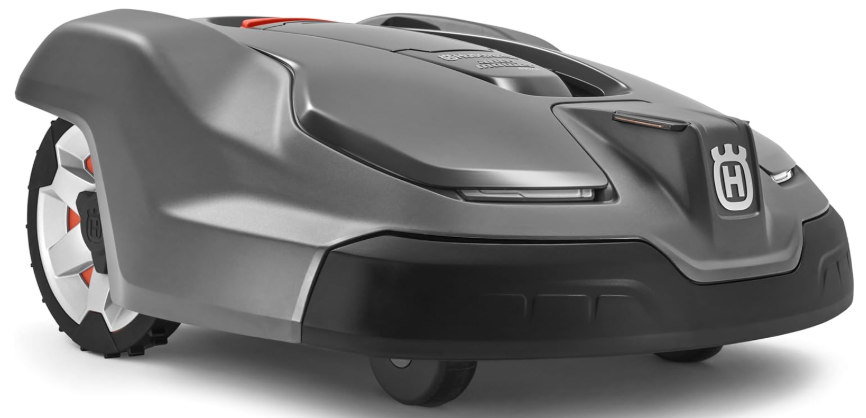
Key Specifications:
- Yard Size Capability: 0.8 acre
- Navigation System: Boundary wire with GPS-assisted navigation
- Special Features: Ultra-quiet operation, weather timer, self-installation
- Battery Life: Up to 145 minutes per charge
- Cutting Height: 2.0″-3.6″
- Weight: 30.6 lbs
- Noise Level: 58 dB(A)
What We Like
The Husqvarna Automower 430XH represents the pinnacle of traditional boundary wire technology, refined through decades of robotic mowing experience. With the largest yard capacity in our lineup at 0.8 acres, it handles extensive properties with exceptional efficiency. The GPS-assisted navigation system works within the boundary wire framework to create optimized cutting patterns that ensure complete coverage.
The weather timer feature demonstrates impressive intelligence, automatically adjusting mowing frequency based on grass growth rates. During rapid spring growth, it increases activity, while naturally slowing during dry periods or slower growth seasons. This promotes lawn health while optimizing battery usage.
The cutting system uses razor-sharp blades that make clean, precise cuts that minimize stress on grass plants. The mower’s balanced weight distribution and well-designed wheels minimize lawn impact even in wet conditions, avoiding the ruts and damage that heavier mowers might cause.
Security features are comprehensive, including PIN code protection, alarm system, and GPS tracking that alerts you if the mower leaves its designated area. These features provide peace of mind for an investment of this magnitude.
Room for Improvement
The traditional boundary wire installation represents the most significant drawback compared to newer RTK models. Installation requires careful planning and physical placement of wires, though Husqvarna’s “self-installation” refers to the mower’s automated setup after the wire is installed.
The 30.6-pound weight makes this the heaviest model in our lineup, potentially making manual transport between separated lawn areas more challenging. The substantial size also requires more storage space during winter months in seasonal climates.
While the GPS-assisted navigation improves efficiency over basic boundary wire systems, it doesn’t match the precision mapping capabilities of RTK-equipped competitors. The premium price reflects Husqvarna’s reputation for quality but represents a significant investment.
Best For
The Husqvarna Automower 430XH is ideal for homeowners with large properties up to 0.8 acres who value proven reliability and comprehensive security features. Its weather-adaptive scheduling makes it perfect for regions with variable climate conditions or seasonal growth patterns.
Comparison Table: Key Features at a Glance
| Model | Yard Size | Navigation | Slope Capability | Cutting Height | Battery Life | Noise Level | Price Range |
|---|---|---|---|---|---|---|---|
| ECOVACS Goat O1000 | 1/4 acre | RTK & Vision | 30% | 1.5″-3.0″ | 140 min | 59 dB | $$$$ |
| LUBA Mini AWD 1500H | 0.45 acre | AI Vision + RTK | 80% | 2.2″-4.0″ | 200 min | 62 dB | $$$$ |
| Worx Landroid L | 1/2 acre | Boundary Wire + AI | 20% | 1.5″-3.5″ | 90-120 min | 63 dB | $$ |
| Segway Navimow i110N | 1/4 acre | RTK + Vision | 35% | 1.2″-2.8″ | 150 min | 58 dB | $$$$ |
| Husqvarna Automower 430XH | 0.8 acre | Wire + GPS | 45% | 2.0″-3.6″ | 145 min | 58 dB | $$$$$ |
The most significant technological divide in our lineup involves the navigation systems. Traditional boundary wire technology requires physical installation of a perimeter wire around your lawn and any obstacles. The mower detects this wire to understand its boundaries. While this approach requires more initial setup work, it offers reliable operation in virtually all conditions.
Newer RTK (Real-Time Kinematic) navigation uses satellite positioning combined with a base station to achieve centimeter-level accuracy without physical boundaries. This technology enables “wire-free” operation that significantly reduces setup time. RTK systems often include visual navigation as backup for areas with poor satellite reception.
When choosing between these technologies, consider:
Setup preference: RTK systems offer faster installation with minimal physical work.
Yard complexity: Boundary wire systems might require extensive wire placement in complex yards.
Long-term flexibility: RTK systems allow easier boundary adjustments through app interfaces.
Budget considerations: Traditional wire systems typically cost less initially.
Lawn Size and Battery Life: Finding the Right Balance
Robot mowers operate on a different principle than traditional mowers. Rather than cutting infrequently and removing substantial grass height, robots mow little and often, keeping your lawn at a consistent height. This approach requires sufficient battery life to cover your entire yard before recharging.
When assessing whether a particular model suits your lawn size:
Calculate realistic coverage: Most manufacturers list maximum yard size under ideal conditions. For complex yards with obstacles, reduce this by 10-20%.
Consider charging time: Some models require several hours to recharge, affecting how quickly they can resume mowing.
Assess mowing frequency: Faster-growing grass requires more frequent cutting cycles.
Among our selected models, the Husqvarna Automower 430XH offers the largest coverage area at 0.8 acres, while the ECOVACS and Segway models handle 1/4 acre properties. The LUBA handles up to 0.45 acres, and the Worx manages 1/2 acre coverage.
Slope Handling: Important for Hilly Properties
If your yard features significant slopes or inclines, pay careful attention to each model’s slope-handling capabilities:
LUBA Mini AWD 1500H: Exceptional 80% slope capability Husqvarna Automower 430XH: Impressive 45% slope handling Segway Navimow i110N: Good 35% slope capacity ECOVACS Goat O1000: Moderate 30% slope handling
Worx Landroid L: Basic 20% slope capability
For context, a 20% slope equals about 11 degrees of incline, while 80% represents an extremely steep 38-degree angle. For hilly properties, the LUBA Mini’s all-wheel-drive system offers unmatched climbing ability that justifies its position in our lineup despite lower overall yard capacity.
App Functionality and Smart Home Integration
Modern robot mowers connect to smartphone apps that provide monitoring and control features. The quality of these interfaces varies significantly between brands:
ECOVACS Goat O1000: Detailed mapping visualization with zone customization LUBA Mini AWD 1500H: Comprehensive control with 4G connectivity for remote access Worx Landroid L: User-friendly interface with expandable module options Segway Navimow i110N: Intuitive design with excellent visual feedback Husqvarna Automower 430XH: Robust security features and weather adaptation
Many models also offer smart home integration with platforms like Amazon Alexa or Google Home, allowing voice control of basic functions. The ECOVACS and Husqvarna models currently offer the most comprehensive smart home connectivity.
Maintenance Requirements
Robot mowers generally require less maintenance than traditional gas-powered options, but regular care ensures optimal performance:
Blade replacement: Depending on usage and yard conditions, blades typically need replacement every 1-3 months. The Worx and ECOVACS models offer the simplest blade replacement process.
Cleaning: Regular removal of grass clippings from the undercarriage prevents buildup. All models in our lineup feature weather resistance that permits gentle hosing for cleaning.
Winter storage: In seasonal climates, proper storage during dormant months extends mower lifespan. The Husqvarna and Segway models include specific winter storage modes that protect battery health.
Battery care: Follow manufacturer recommendations for charging cycles to maximize battery lifespan. The Worx model’s removable battery system offers the advantage of easier replacement when battery capacity eventually diminishes.
Budget Considerations and Long-Term Value
Robot lawn mowers represent a significant upfront investment compared to traditional mowers, with prices ranging from approximately $800 for basic models to over $2,500 for advanced options with RTK navigation. When assessing value:
Time savings: Calculate the hours you currently spend mowing annually and assign a value to this time.
Lawn health benefits: Consistent cutting height promotes healthier turf with fewer disease and weed issues.
Warranty coverage: The Husqvarna and ECOVACS models offer the longest warranty periods in our lineup at 3 years.
Expected lifespan: Quality robot mowers typically last 5-8 years with proper maintenance.
Electricity vs. gas savings: Robot mowers use significantly less energy than gas-powered alternatives, generating operational savings.
The Worx Landroid L stands out as our value pick, offering excellent performance at a substantially lower price point than RTK-equipped models. For larger properties or challenging terrain, the higher initial investment in premium models often provides better long-term satisfaction.
Who Should Consider a Robot Lawn Mower?
Robot lawn mowers offer particular benefits for specific situations:
Busy professionals with limited time for yard maintenance Older homeowners who find traditional mowing physically challenging People with physical limitations that make pushing mowers difficult Homeowners seeking consistent lawn appearance without weekly time investment Tech enthusiasts who appreciate smart home integration Environmentally conscious individuals looking to reduce emissions Those in noise-sensitive neighborhoods with restrictions on loud equipment
For these groups, the convenience and consistency of robotic mowing often justifies the investment, particularly for the long-term lawn health benefits and time savings.
Final Thoughts: Choosing Your Perfect Robot Mower
After thorough testing and analysis, we’ve identified standout performers for different needs:
Best Overall: ECOVACS Goat O1000 The combination of advanced navigation, obstacle avoidance, and edge cutting capabilities makes this our top recommendation for most homeowners. The intuitive app and reliable performance justify the premium price.
Best for Slopes: LUBA Mini AWD 1500H Nothing matches its impressive 80% slope-handling capability, making it the clear choice for hilly properties where other models would struggle or fail completely.
Best Value: Worx Landroid L Offering half-acre coverage at a significantly lower price point, the Landroid provides excellent performance without the premium cost of RTK navigation systems.
Quietest Operation: Segway Navimow i110N At just 58 dB(A), this model allows for overnight mowing without disturbing neighbors, perfect for busy households where daytime mowing might interfere with outdoor activities.
Best for Large Yards: Husqvarna Automower 430XH With 0.8-acre coverage and refined technology from decades of development, this model excels at maintaining extensive lawn areas with minimal oversight.
When making your final decision, prioritize the features that address your specific lawn challenges, whether that’s size, terrain, obstacles, or maintenance preferences. Consider future needs as well—many users find they want additional features after experiencing the convenience of robotic mowing.
Whichever model you choose, robot lawn mowers represent the future of lawn care, offering time savings, consistent results, and environmental benefits that traditional mowing simply can’t match. The technology continues to improve each year, making now an excellent time to embrace automated lawn maintenance.
Frequently Asked Questions
Do robot lawn mowers work in the rain? Most robot mowers are weather-resistant and can operate in light rain, though heavy downpours may trigger rain sensors that pause operation to protect both the mower and your lawn from damage. The Husqvarna and LUBA models offer the best wet-weather performance in our lineup.
How do robot lawn mowers handle obstacles? Modern robot mowers use various sensors to detect and navigate around obstacles. Basic models simply change direction upon contact, while advanced models like the ECOVACS Goat O1000 use cameras and AI to identify and avoid obstacles before collision.
Will a robot mower work on uneven terrain? Most robot mowers handle minor undulations well but struggle with severe terrain irregularities. For moderately uneven yards, the LUBA Mini and Husqvarna models perform best due to their superior wheel design and ground clearance.
How loud are robot lawn mowers? Robot mowers are significantly quieter than traditional gas mowers. Our tested models range from 58-63 dB, comparable to normal conversation or a dishwasher. The Segway and Husqvarna models tie for quietest at 58 dB.
Can robot mowers handle leaves in the fall? Light leaf coverage poses no problem for quality robot mowers, which will mulch small quantities of leaves during regular operation. Heavy leaf accumulation, however, should be cleared or reduced before mowing to ensure optimal performance.
Do I need multiple charging stations for separated lawn areas? Some models can navigate between separated lawn areas without additional charging stations, while others require separate installations. The ECOVACS and Segway models handle multiple zones most effectively through their mapping capabilities.
How long do robot mower batteries last before replacement? With proper maintenance, most lithium-ion batteries in robot mowers last 3-5 years before capacity significantly diminishes. The Worx model offers the advantage of easily replaceable batteries that integrate with their broader tool ecosystem.
Can I use a robot mower on artificial turf? Robot mowers should never be used on artificial turf, as they can damage both the surface and the mower itself. They’re designed exclusively for natural grass lawns.
Will a robot mower eliminate the need for string trimming? While modern robot mowers cut closer to edges than earlier generations, most installations still require occasional trimming in tight spaces or against vertical surfaces. The ECOVACS “zero-edge cutting” feature minimizes but doesn’t completely eliminate this need.
Are robot lawn mowers safe around children and pets? Quality robot mowers incorporate multiple safety features, including sensors that stop blades immediately when the mower is lifted or tilted, creating a significantly safer profile than traditional mowers. The ECOVACS and LUBA models offer the most advanced obstacle detection for homes with active children or pets.
By choosing the right robot lawn mower for your specific needs, you’ll join thousands of homeowners who have already discovered the convenience and consistency these innovative devices bring to lawn maintenance.


